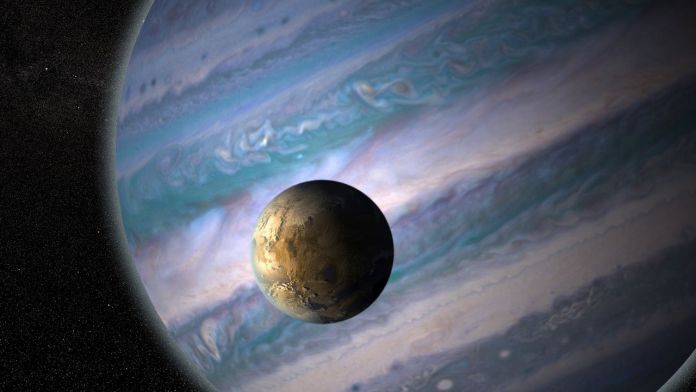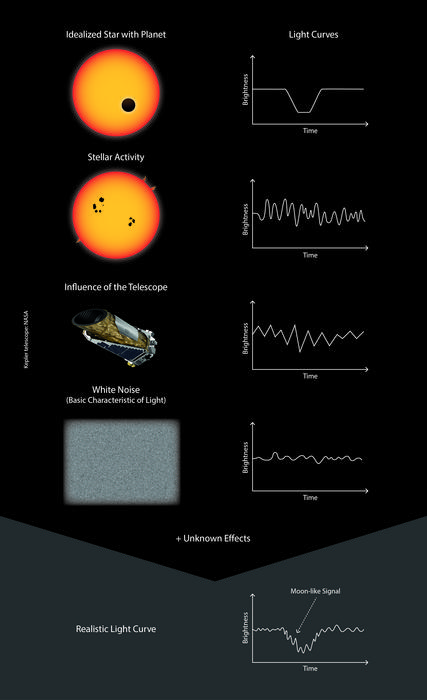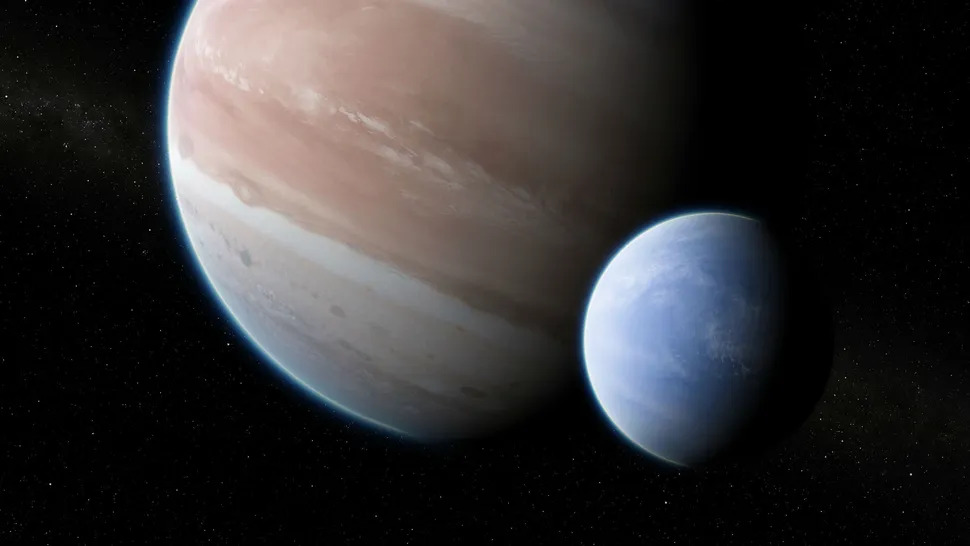Are they exomoons or not? Scientists debate existence of 1st moons seen beyond our solar system
Team "pro-exomoon" is back to defend the discovery of the first and only exomoons potentially seen by humanity.

Astronomers always knew spotting moons around planets outside the solar system would be no mean feat — but a debate currently raging in planetary science circles shows just how tough detecting these so-called exomoons is going to be.
The story begins in 2018, when astronomers including David Kipping, an assistant professor of astronomy at Columbia University, believed they'd made their first detection of an exomoon. The subject was found around exoplanet Kepler-1625b, a Jupiter-like world located around 8,000 light years from Earth. It was initially spotted with the Kepler Space Telescope.
Upon its alleged discovery, Kepler-1625b's moon was aptly dubbed "Kepler-1625 b I." Later, it was seemingly further confirmed with data from the Hubble Space Telescope. Then, in 2022, another team, also including Kipping, appeared to have discovered a second exomoon, this time with the Kepler Space Telescope alone. This subject was supposedly seen orbiting Kepler-1708 b, a gas giant located around 5,400 light-years from Earth with a mass 4.6 times that of Jupiter. The potential second exomoon had a similar name to the first; it was designated "Kepler-1708 b I."
Related: That’s no moon! Scientists doubt proposed detection of the 1st exomoons
These two moons were like nothing found in the solar system. They both exhibited sizes greater than Earth's, for instance, which made them similar in scale to a class of exoplanets called "mini-Neptunes." In that respect, the first exomoons seemed to reflect some of the first exoplanet discoveries, which included things scientists hadn't expected to see like Jupiter-size worlds snuggled up to their stars and planets orbiting rapidly spinning neutron stars called pulsars.
Though the discoverers of Kepler-1625 b I and Kepler-1708 b I — let's call them "team pro-exomoon" — kept an open mind regarding the moons' existence, and still to this day urge healthy skepticism, it seemed fairy certain that humanity had found its first exomoons after decades of locating only exoplanets.
That was until late 2023, when a separate team of astronomers led by Max Planck Institute for Solar System Research scientist René Heller — "team no-exomoon" if you will — cast doubt on both exomoon discoveries in a paper published in the journal Nature Astronomy.
Breaking space news, the latest updates on rocket launches, skywatching events and more!
Kipping and colleagues have now fired back, producing a research paper that appears in a preprint version of the paper repository arXiv and defending their exomoon findings.
"I believe that Kepler-1625b and Kepler-1708b are perfectly valid exomoon candidates, and I think we've shown that convincingly," Kipping told Space.com. "So what do I think is really going on, and why didn't they get the moon?"
An exomoon discrepancy
The technique used to detect these two exoplanets is similar to the transit method, which has delivered a great swath of the over 5,000 planets in the exoplanet catalog thus far.
The transit method hinges on the detection of a tiny dip in light coming from the parent star of a planet, created as that world crosses or "transits" the face of that star from our vantage point in the cosmos. The same principle applies to exomoons, albeit on a vastly smaller scale. If these moons are in precisely the right position around the planet they orbit as that planet transits its star, that too should cause a dip in light, albeit a more insignificant one.
Such a mini-light-dip, however, is the clue that suggested the existence of Kepler-1625 b I and Kepler-1708 b I to team pro-exomoon. Yet, because this dip in light output caused by the transit of an exomoon is so tiny, it can't be directly seen. Instead, it takes powerful computing software algorithms to tease it out of telescope data.
Kipping says that both his "pro-exomoon" team and Heller's "no-exomoon" team used the same data from the same telescopes, but the disappearance of Kepler-1625 b I and Kepler-1708 b I could be due to how the teams treated that data via the algorithms employed.
Kipping told Space.com that team "no-exomoon" may have missed Kepler-1708 b I due to the software they chose for analyzing the Hubble and Kepler telescope data. Though the software is related to the one he and the "pro-exomoon" team used, it's still slightly different.
"The software packages we used are almost twins of each other. Their package is a lot newer. It's only been around for a couple of years, whereas the one we're using has been around for about ten years or so, maybe even longer," Kipping explained. "The true answer is that their algorithm is unable to find the moon. Not that the moon isn't there in their data."
Kipping also suggests that the "no-exomoon" team used their software, which is usually very reliable, outside its default mode and rather in a mode that is sensitive to the number of steps used to treat data. This may explain why the exomoons were missed during their calculations.
For Kepler-1625 b I, Heller and his "no-exomoon" team suggested an effect called "stellar limb darkening," which means that the edges of a star are darker than its center, impacting the proposed exomoon signal. Heller's team argues that stellar limb darkening would actually better explain observations of the parent star than darkening caused by the presence of an exomoon.
Kipping argues this isn't a valid case against the exomoon candidates because he and his "pro-exomoon" team already accounted for such limb darkening when they first proposed the existence of Kepler-1625 b I.
"We accounted for limb darkening in the original paper, so it's not like we screwed up and forgot about it, he explained. "I think this hole point's kind of a red herring in my book; it doesn't affect the argument for the exomoon."
Lead researcher of the exomoon debunking team, René Heller, has looked at the return paper from Kipping and team but isn't swayed into believing Kepler-1625 b I and Kepler-1708 b I exist.
"I do not see anything new in the paper that would change my opinion about Kepler-1625b and Kepler-1708b being planets without big moons. Their new paper circles mostly about our work and tries to find weaknesses in our line of reasoning. This is a natural and very welcome process in modern science, although in this case I don't see any significant progress," Heller told Space.com. "I refute the idea of refuting their refutal of our refutal of their claim. I think the debate remains unsettled, and this is ok. Let's move on!"
The idea of moving on is something that Heller and Kipping agree on — at least for now.
Are Kepler-1625 b I and Kepler-1708 b just too "weird?"
The whole reason these exomoons showed up in the transit method is that they are huge mini-Neptune-size bodies that could have diameters between 1.6 times to 4 times that of Earth. If they're there, they're huge.
Kipping thinks that's part of what could make them just too unusual to be widely accepted as the first exomoon discoveries.
"I think there is a lot of suspicion about Kepler-1625 b I and Kepler-1708 b I because they're both weird. They're both like these mini-Neptune size moons, right? And everyone is asking, 'Who ordered that? How does the universe make such bizarre stuff?'" he said. "And then this controversy doesn't help at all. They're too damaged now."
Kipping now intends to use the James Webb Space Telescope (JWST) to search for exomoons that are closer analogs to the moons we see within the solar system.
"My strategy, and maybe it's the wrong strategy, is let's see if we can get some more familiar moons with the JWST, analogs to moons we have in our solar backyard like Io and Europa," he said. "Hopefully, that will build confidence that saw these exomoons back then and that they were really interesting, and we should go back and look at them again."
Kipping is very clear that the disagreement between the team's conclusions doesn't reflect poorly on either set of scientists regardless of the final answer, "exomoon" or "no exomoon." Instead, it simply shows how challenging the detection of moons around planets outside the solar system is going to be until major advancements are made in telescope technology.
"It's very challenging work, and I would not pretend otherwise. When looking for exomoons, we are searching for a signal which none of these telescopes are designed to detect," he said. "We think we can get that kind of science out of them. But it's pushing these instruments, especially Kepler and Hubble, to the very edge of what they're capable of doing.
"So the decisions you make and the choices you make into how, what algorithms you use, how you treat the data, can make the difference between success and failure."
Kipping believes this disagreement between the two teams offers exomoon-hunting scientists the opportunity to compare methods and converge on the best approach for hunting these tiny distant bodies.
Hopefully, a refined exomoon detection method could one day lead to these two sets of talented and passionate scientists uniting on an exomoon detection they can agree on.

Robert Lea is a science journalist in the U.K. whose articles have been published in Physics World, New Scientist, Astronomy Magazine, All About Space, Newsweek and ZME Science. He also writes about science communication for Elsevier and the European Journal of Physics. Rob holds a bachelor of science degree in physics and astronomy from the U.K.’s Open University. Follow him on Twitter @sciencef1rst.


